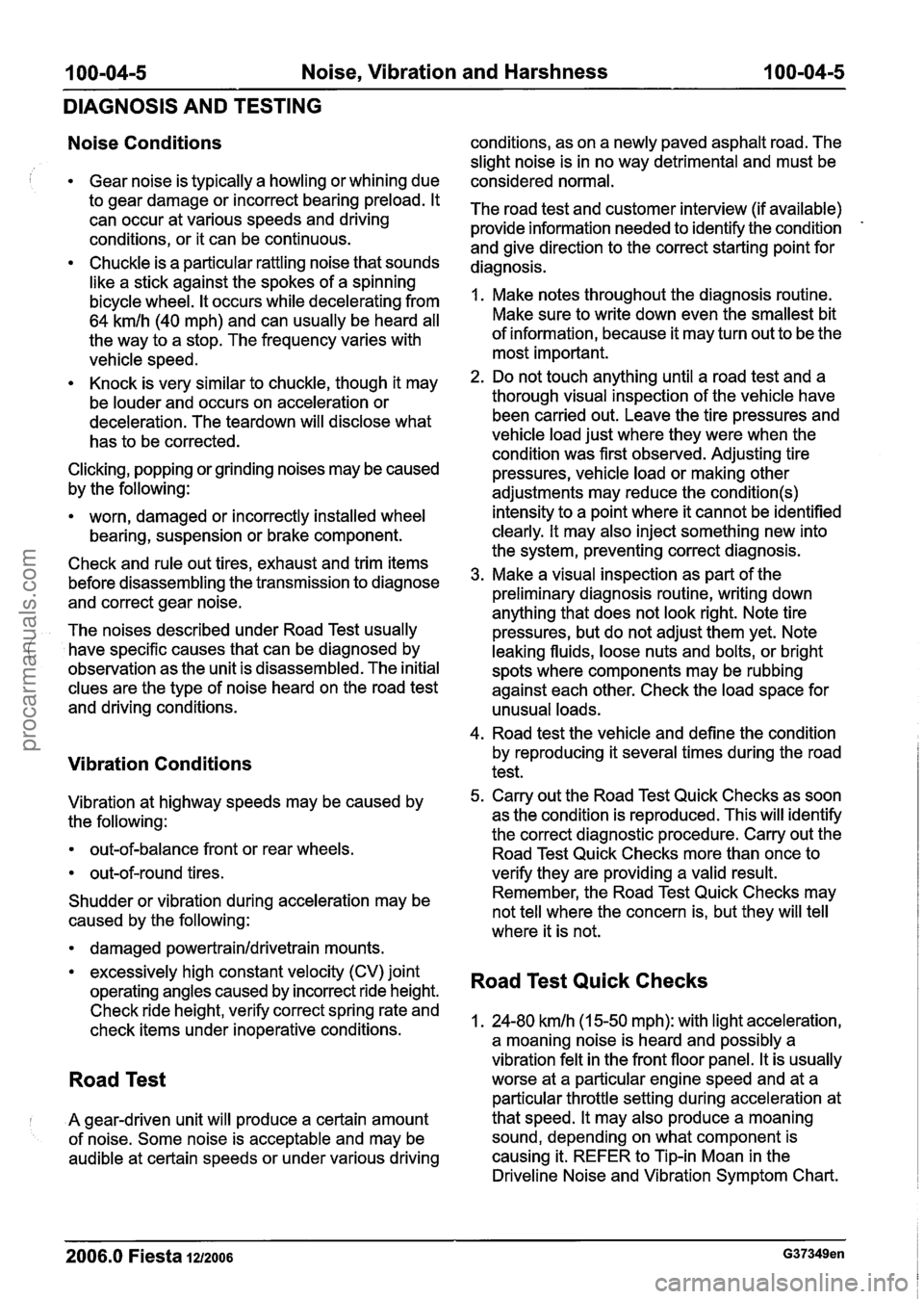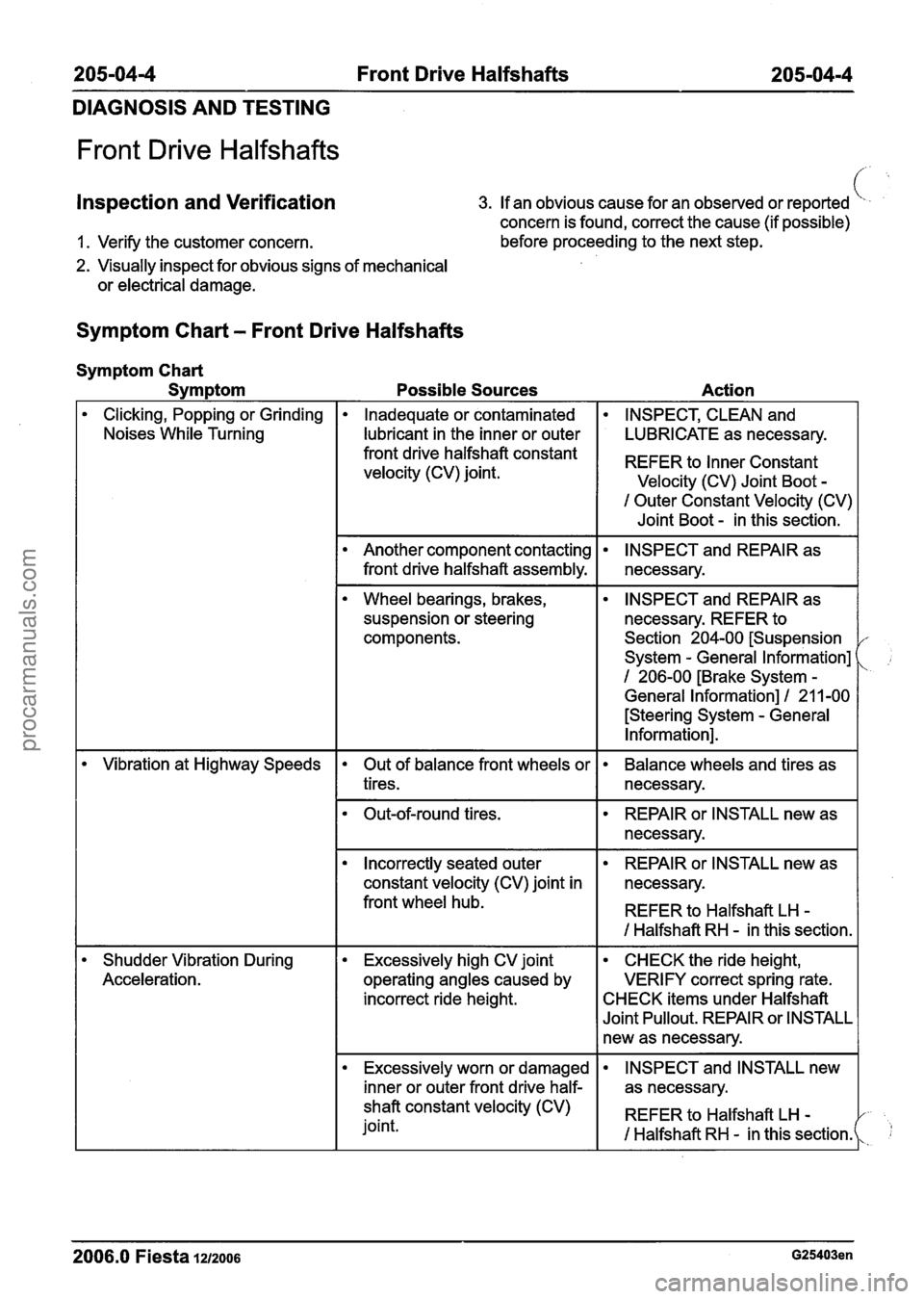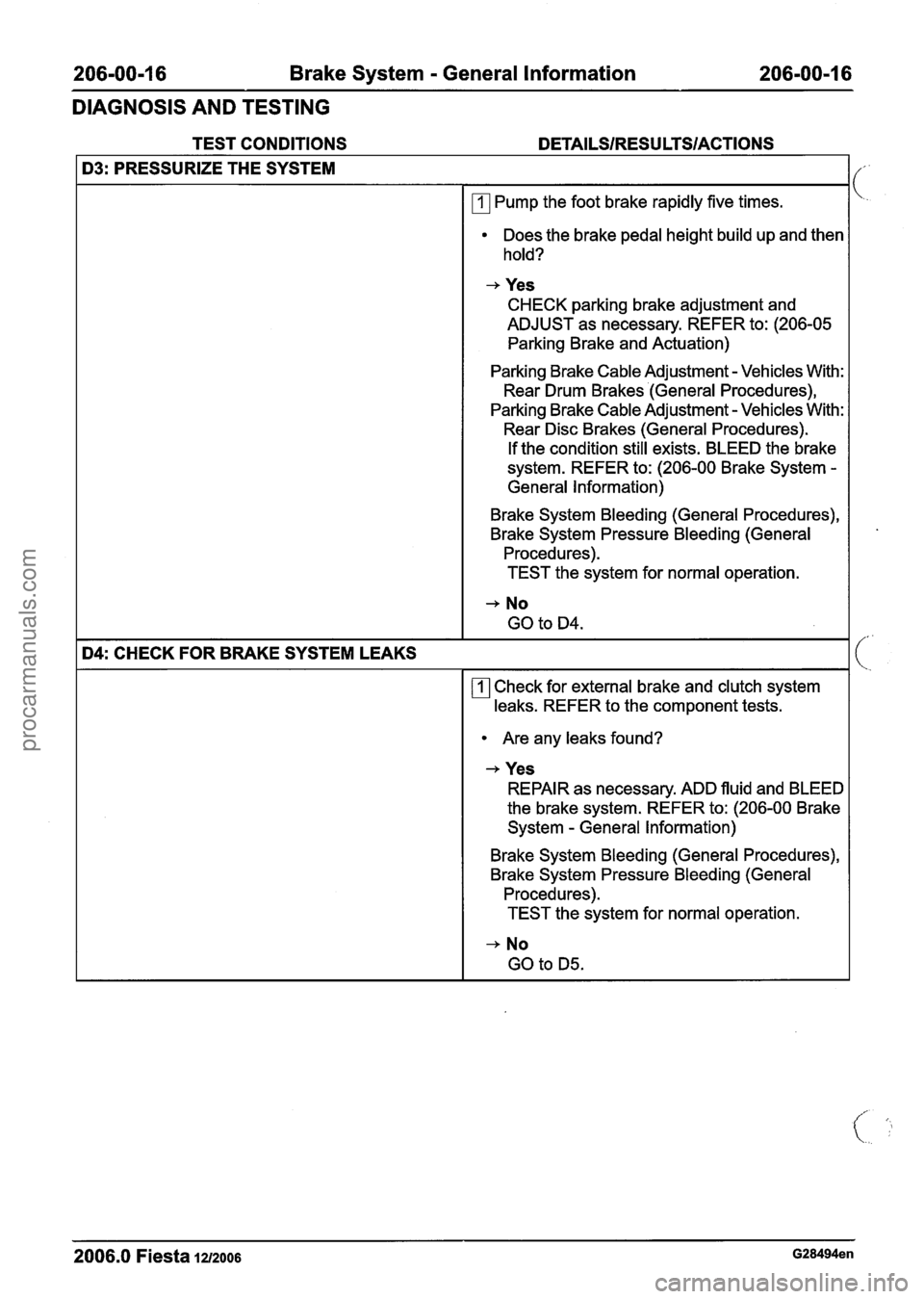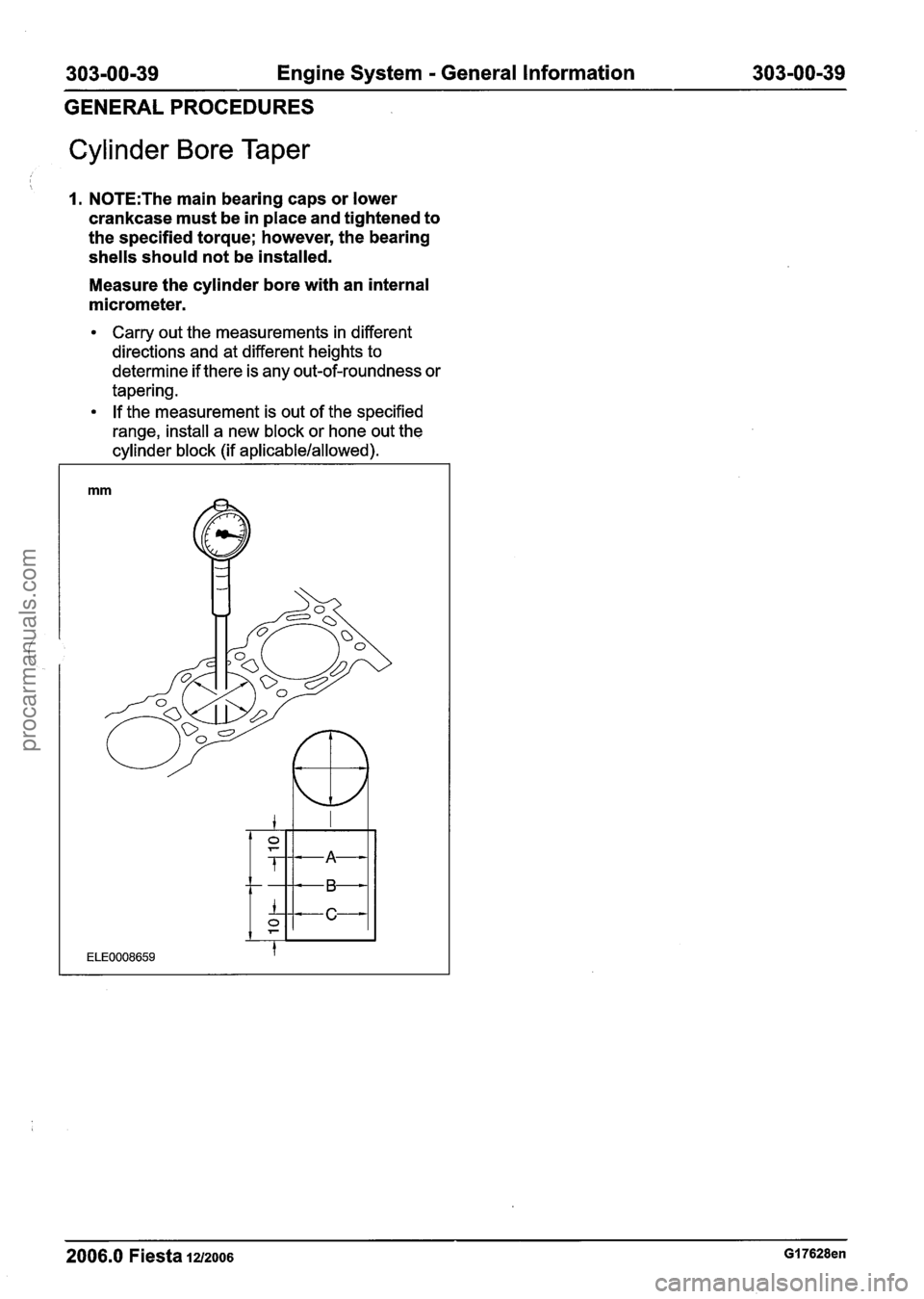height FORD FIESTA 2007 Workshop Manual
[x] Cancel search | Manufacturer: FORD, Model Year: 2007, Model line: FIESTA, Model: FORD FIESTA 2007Pages: 1226, PDF Size: 61.26 MB
Page 61 of 1226

100-04-5 Noise, Vibration and Harshness 100-04-5
DIAGNOSIS AND TESTING
Noise Conditions
Gear noise is typically a howling or whining due
to gear damage or incorrect bearing preload. It
can occur at various speeds and driving
conditions, or it can be continuous.
Chuckle is a particular rattling noise that sounds
like a stick against the spokes of a spinning
bicycle wheel. It occurs while decelerating from
64
kmlh (40 mph) and can usually be heard all
the way to a stop. The frequency varies with
vehicle speed.
Knock is very similar to chuckle, though it may
be louder and occurs on acceleration or
deceleration. The
teardown will disclose what
has to be corrected.
Clicking, popping or grinding noises may be caused
by the following:
worn, damaged or incorrectly installed wheel
bearing, suspension or brake component.
Check and rule out tires, exhaust and trim items
before disassembling the transmission to diagnose
and correct gear noise.
The noises described under Road Test usually
( have specific causes that can be diagnosed by
observation as the unit is disassembled. The initial
clues are the type of noise heard on the road test
and driving conditions.
Vibration Conditions
Vibration at highway speeds may be caused by
the following:
out-of-balance front or rear wheels.
out-of-round tires.
Shudder or vibration during acceleration may be
caused by the following:
damaged powertrainldrivetrain mounts.
excessively high constant velocity (CV) joint
operating angles caused by incorrect ride height.
Check ride height, verify correct spring rate and
check items under inoperative conditions.
Road Test
I A gear-driven unit will produce a certain amount
of noise. Some noise is acceptable and may be
audible at certain speeds or under various driving conditions,
as on a newly paved asphalt road. The
slight noise is in no way detrimental and must be
considered normal.
The road test and customer interview (if available)
provide information needed to identify the condition
-
and give direction to the correct starting point for
diagnosis.
1. Make notes throughout the diagnosis routine.
Make sure to write down even the smallest bit
of information, because it may turn out to be the
most important.
2. Do not touch anything until a road test and a
thorough visual inspection of the vehicle have been carried out. Leave the tire pressures and
vehicle load just where they were when the
condition was first observed. Adjusting tire
pressures, vehicle load or making other
adjustments may reduce the
condition(s)
intensity to a point where it cannot be identified
clearly. It may also inject something new into
the system, preventing correct diagnosis.
3. Make a visual inspection as part of the
preliminary diagnosis routine, writing down
anything that does not look right. Note tire
pressures, but do not adjust them yet. Note
leaking fluids, loose nuts and bolts, or bright
spots where components may be rubbing
against each other. Check the load space for
unusual loads.
4. Road test the vehicle and define the condition
by reproducing it several times during the road
test.
5. Carry out the Road Test Quick Checks as soon
as the condition is reproduced. This will identify
the correct diagnostic procedure. Carry out the
Road Test Quick Checks more than once to
verify they are providing a valid result.
Remember, the Road Test Quick Checks may
not tell where the concern is, but they will tell
where it is not.
Road Test Quick Checks
1. 24-80 kmlh (1 5-50 mph): with light acceleration,
a moaning noise is heard and possibly a
vibration felt in the front floor panel. It is usually
worse at a particular engine speed and at a
particular throttle setting during acceleration at
that speed. It may also produce a moaning
sound, depending on what component is
causing it. REFER to Tip-in Moan in the
Driveline Noise and Vibration Symptom Chart.
2006.0 Fiesta 1212006 G37349en
procarmanuals.com
Page 79 of 1226

100-04-23 Noise, Vibration and Harshness 100-04-23
GENERAL PROCEDURES
PowertrainIDrivetrain Mount Neutralizing(l4 001 0)
N0TE:There is no procedure for neutralizing the
powertrainldrivetrain mounts. To check the
alignment of the powertrain mounts visually,
proceed as follows.
I. Loosen the rear support insulator retaining
bolts (if equipped).
2. Loosen the powertrainldrivetrain mount
retaining bolts.
3. N0TE:Support the powertrainldrivetrain in
an approximate position and height.
N0TE:Make sure that the right-hand mount and
left-hand insulator align over the studs on the
powertrain and drivetrain to allow the fixings to be
assembled through the large holes in the support
insulator bracket without overstraining.
Check the powertrainldrivetrain mount
alignment.
4. Tighten the powertrainldrivetrain mount to
powertrainldrivetrain mount bracket retaining
bolts.
5. Tighten the powertrainldrivetrain mount to
body retaining bolts.
6. Tighten the rear support insulator retaining
bolts (if equipped).
2006.0 Fiesta 1212006 GI 7382en 1
procarmanuals.com
Page 156 of 1226

205-0414 Front Drive Halfshafts 205-04-4
DIAGNOSIS AND TESTING
Front Drive Halfshafts
Inspection and Verification 3. If an obvious cause for an observed or reported
concern is found, correct the cause (if possible) c.# '
1. Verify the customer concern. before proceeding
to the next step.
2. Visually inspect for obvious signs of mechanical
or electrical damage.
Symptom Chart - Front Drive Halfshafts
Symptom Chart
Symptom
Possible Sources Action
Clicking, Popping or Grinding
Noises While Turning Inadequate or contaminated INSPECT, CLEAN and
I lubricant in the inner or outer I LUBRICATE as necessary.
I Outer Constant Velocity (CV)
I Joint Boot - in this section.
front drive halfshaft constant
velocity (CV) joint.
REFER to Constant
Velocity (CV) Joint Boot -
Wheel bearings, brakes,
suspension or steering
components.
Another component contacting
front drive halfshaft assembly.
--
INSPECT and REPAIR as
necessary. REFER to
Section 204-00 [Suspension
System
- General Information]
1 206-00 [Brake System -
General Information] I 21 1-00
[Steering System
- General
Information].
INSPECT and REPAIR as
necessary.
- --
Vibration at Highway Speeds
Shudder Vibration During
Acceleration. Out of balance front wheels or
tires. Balance wheels and tires as
necessary.
I Incorrectly seated outer I REPAIR or INSTALL new as I
Out-of-round tires.
constant velocity (CV) joint in necessary.
front wheel hub.
I REFER to Halfshaft LH -
REPAIR or INSTALL new as
necessary.
I I I Halfshaft RH - in this section. I
Excessively high CV joint
operating angles caused by
incorrect ride height. CHECK the ride height,
VERIFY correct spring rate.
CHECK items under Halfshaft
Joint Pullout. REPAIR or INSTALL
new as necessary.
Excessively worn or damaged
I inner or outer front drive half-
- - - - --
2006.0 Fiesta 1212006 G25403en
INSPECT and INSTALL new
as necessary.
shaft constant velocity (CV)
joint. REFER
to Halfshaft LH
-
I Halfshaft RH - in this sectionk 1;
procarmanuals.com
Page 188 of 1226

206-00-1 6 Brake System - General Information 206mOO-16
DIAGNOSIS AND TESTING
TEST CONDITIONS
2006.0 Fiesta 12/2006 G28494en
D3: PRESSURIZE THE SYSTEM
D4: CHECK FOR BRAKE SYSTEM LEAKS
Pump the foot brake rapidly five times.
Does the brake pedal height build up and then
hold?
+ Yes
CHECK parking brake adjustment and
ADJUST as necessary. REFER to: (206-05
Parking Brake and Actuation)
Parking Brake Cable Adjustment
- Vehicles With:
Rear Drum Brakes (General Procedures),
Parking Brake Cable Adjustment
- Vehicles With:
Rear Disc Brakes (General Procedures).
If the condition still exists. BLEED the brake
system. REFER to: (206-00 Brake System
-
General Information)
Brake System Bleeding (General Procedures),
Brake System Pressure Bleeding (General
Procedures). TEST the system for normal operation.
+ No
GO to D4.
Check for external brake and clutch system
leaks. REFER to the component tests.
Are any leaks found?
+ Yes
REPAIR as necessary. ADD fluid and BLEED
the brake system. REFER to: (206-00 Brake
System
- General Information)
Brake System Bleeding (General Procedures),
Brake System Pressure Bleeding (General
Procedures). TEST the system for normal operation.
+ No
GO to D5.
procarmanuals.com
Page 461 of 1226

303-00-39 Engine System - General Information 303-00-39
GENERAL PROCEDURES
Cylinder Bore Taper
1. N0TE:The main bearing caps or lower
crankcase must be in place and tightened to
the specified torque; however, the bearing
shells should not be installed.
Measure the cylinder bore with an internal
micrometer.
Carry out the measurements in different
directions and at different heights to
determine if there is any out-of-roundness or
tapering.
If the measurement is out of the specified
range, install a new block or hone out the
cylinder block (if
aplicable/allowed).
2006.0 Fiesta 1212006 GI 7628en
procarmanuals.com
Page 845 of 1226

303-05-7 Accessory Drive 303-05-7
DIAGNOSIS AND TESTING
3. Longer pills up to 50% of the rib height. 4.
Longer pills up to 50% of the rib height.
Possible noise concern. INSTALL a new belt Possible noise
concern. INSTALL a new belt
if noise is apparent. if noise is apparent.
REFER to: Accessory Drive Belt
- 1.3L
Duratec-8V (Rocam) (303-05 Accessory
Drive, Removal and Installation)
1 Accessory Drive Belt
- 1.4L Duratec-16V
(Sigma)/l .6L Duratec-I 6V (Sigma),
Vehicles With: Air Conditioning (303-05
Accessory Drive, Removal and lnstallation)
1 Power Steering Pump Belt
- I .4L
Duratec-1
6V (Sigma)ll .6L Duratec-I 6V
(Sigma), Vehicles With: Air Conditioning
(303-05 Accessory Drive, Removal and
Installation)
1 Accessory Drive Belt
- 1.4L Duratec-I 6V
(Sigma)ll .6L Duratec-I 6V (Sigma),
Vehicles Without: Air Conditioning (303-05
Accessory Drive, Removal and Installation)
1 Accessory Drive Belt
- 1.4L Duratorq-TDCi
(DV) Diesel (303-05 Accessory Drive,
Removal and Installation)
I Accessory Drive Belt - 1.6L Duratorq-TDCi
(DV) Diesel (303-05 Accessory Drive,
Removal and Installation)
1 Accessory Drive Belt
- 2.OL Duratec-HE
(M14) (303-05 Accessory Drive, Removal
and Installation). REFER to:
Accessory Drive Belt
- I .3L
Duratec-8V
(Rocam) (303-05 Accessory
Drive, Removal and Installation)
1 Accessory Drive Belt
- I .4L Duratec-1 6V
(Sigma)ll .6L Duratec-1 6V (Sigma),
Vehicles With: Air Conditioning (303-05
Accessory Drive, Removal and lnstallation)
I Power Steering Pump Belt - I .4L
Duratec-1
6V (Sigma)ll .6L Duratec-I 6V
(Sigma), Vehicles With: Air Conditioning
(303-05 Accessory Drive, Removal and
Installation)
I Accessory Drive Belt - I .4L Duratec-I 6V
(Sigma)ll .6L Duratec-1 6V (Sigma),
Vehicles Without: Air Conditioning (303-05
Accessory Drive, Removal and lnstallation)
1 Accessory Drive Belt
- 1.4L Duratorq-TDCi
(DV) Diesel (303-05 Accessory Drive, Removal and Installation)
1 Accessory Drive Belt
- 1.6L Duratorq-TDCi
(DV) Diesel (303-05 Accessory Drive,
Removal and Installation)
1 Accessory Drive Belt
- 2.OL Duratec-HE
(M14) (303-05 Accessory Drive, Removal
and Installation).
2006.0 Fiesta 1212006 G346263en
procarmanuals.com